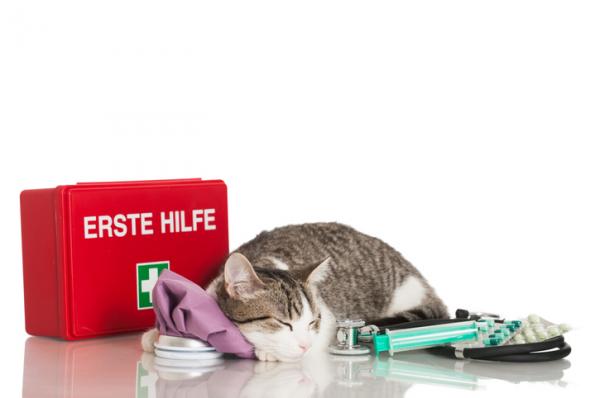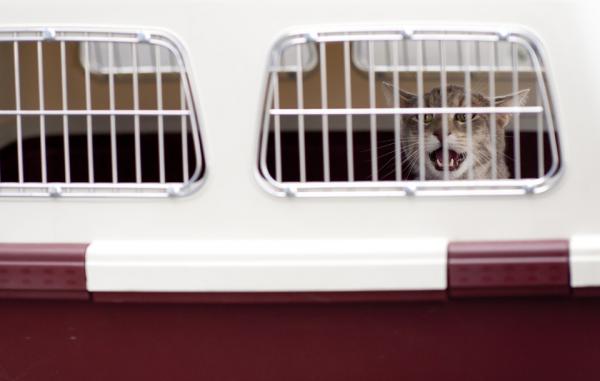First aid in cats

Cats are very independent companion animals and even have a reputation for being rough, but we know that this is not the case and that they are as capable as any other pet of showing their affection and of establishing an important emotional bond with their owner.
As a result of this genuine, independent and exploratory nature, the cat can suffer some accident, and although in these cases it will be essential to go to the veterinarian as soon as possible, it will also be necessary for us to act with knowledge and speed. In this article we show you what are the first aid in cats what you should know
Make an evaluation of your cat
If our cat has suffered an accident we should not attend to it because we do not have the necessary knowledge, therefore it is essential to have the contact of an veterinarian on duty.
However, if it will be our auxiliary function to our pet and prepare to offer the necessary information to the veterinarian, in order to expedite the attention.
For this we must make an initial assessment of the state of our cat, we must fleave us in the following aspects:
- Breathing and pulse
- Degree of consciousness
- Body temperature
- Behavior
- Color of mucous membranes
- Pupils
- Existence of hemorrhages
First aid for dehydrated cats
Dehydration in cats is a dangerous situation that threatens our pets during the warmer months of the year. A dehydrated cat will show the dry and sticky gums and a skin lack of elasticity. You will notice this clearly if you pinch your skin, as it will return in a strangely slow way to its initial position.
You must prepare to take the cat to the veterinarian but first you must initiate an oral administration of physiological serum or saline, which you’ll easily find at any pharmacy. If you can not go, you can make saline at home, you will only need 1 small spoonful of sea salt for each 250 milliliters of water (one glass). If you do not drink directly from your bowl of water, you can wrap it in a towel and administer it with a syringe without tip and in a controlled manner the serum. Discover some homemade remedies for dehydrated cats that can help you in an emergency.
First aid for injured cats
A wounded cat can be aggressive and therefore it will also be important that we handle it with extreme care. Gloves can help, but in some cases it may be convenient to wrap it completely with a towel to study your vital signs. The cat can present internal and external wounds:
The external wound it will be easily visible and we will have to act as soon as possible if the animal is losing blood, pressing the wound with gauze for about 10 minutes to stop the bleeding. If it is shallow, we can use oxygenated water for the wounds in the cat, as well as betadine, however, we must avoid that it can get to lick itself. If the wound is very deep the risk of infection is safe, so we can stop the bleeding but it will also be necessary to visit a veterinarian to administer antibiotics.
In the case of internal bleeding in cats we will observe symptoms such as cold extremities, rapid breathing, pale gums or lethargy. Internal wounds require immediate veterinary attention so the ideal thing would be to go as soon as possible to the specialist trying to manipulate the animal as little as possible.
First aid for cats with clogged airways
In some cases we can find the presence of a foreign body in the throat of our cat that causes respiratory distress, it is a serious situation that must be treated quickly to avoid suffocation.
If the cat is still breathing and has consciousness, you should try to calm it down and take out that object with your hands or with the help of tweezers. We recommend asking for help from a relative or acquaintance since the cat can you try to bite.
In the event that the cat has lost consciousness, you should lay it on its side and press with the hand from the throat to the head to facilitate the exit of the object, another drastic but effective option is to place the cat face down to force the exit of the body strange.
First aid for poisoned cats
The cat can be poisoned through multiple substances, from toxic plants to cleaning products, if you know what your cat has been poisoned with, a sample to the vet. Here are some tips for poisoning in cats:
- If the cat has been poisoned by a toxic food or plant, you can Induce vomiting. To do this, insert a finger into the throat and press gently.
- If the cat has ingested a corrosive or acidic substance, such as bleach or ammonia, do not induce vomiting, Give him milk to drink to neutralize the toxins. If the cat seems not to want to ingest it, help yourself with a small syringe without a tip.
- Finally, if you do not know what substance has been ingested, do not induce vomiting or give them anything to drink, this could aggravate their state of health.
Find out more about poisoning in cats in our full article.

First aid for cats with fractures
A bad fall can cause a fracture in a cat that will be clearly perceived as the cat will show signs of pain and difficulty of movement. In these cases it is a priority keep the cat motionless, for this we can use the carrier, a cardboard to support the cat and hold it with cloth tapes or a towel.
If the fracture is open, the wound will show bleeding, and as we mentioned above it is necessary to apply pressure to stop the bleeding, but with great care so as not to aggravate the fracture.

What to do in case of an accident?
It is important to know what has happened to our cat and for this we must observe its condition, secondly we will apply the first aid that correspond, finally we will contact the veterinarian and we will take it to the clinic as comfortable as possible and completely immobilized in the cases that require it.
This article is merely informative, in .com we do not have the faculty to prescribe veterinary treatments or make any kind of diagnosis. We invite you to take your pet to the veterinarian in case of any type of condition or discomfort.
If you want to read more articles similar to First aid in cats, we recommend that you enter in our First Aid section.


